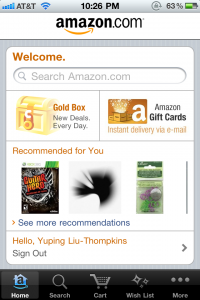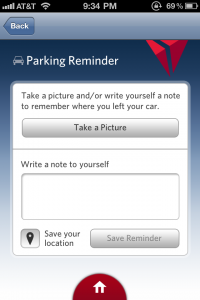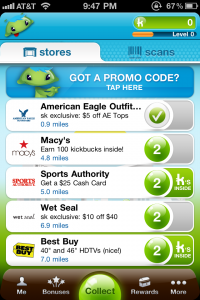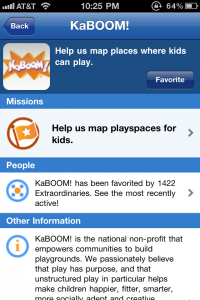With Verizon finally carrying iPhone and iPad and mass merchandisers such as Walmart selling smartphones on the cheap, the number of smart phones and mobile devices is bound to soar. This presents loyalty marketers a great additional touch point with their customers through mobile apps. What functionality should a marketer pack in a mobile app? To answer this question, in this blog, I’d like to take a look at different uses of mobile apps that have appeared in the marketplace.
Mobile Transaction Platform

Major retailers such as Amazon.com and eBay have developed their mobile apps that allow consumers to buy products directly from within the app. Compared with a mobile commerce website, these apps tend to be more user-friendly and incorporate the touch and swipe capabilities of smartphones for easier manipulation of product pictures, smoother transition between pages, and overall faster shopping experience.
Point-of-Sales Integration

Short of offering full mobile transaction capabilities, another type of app tries to mesh the mobile device with POS transactions in the physical world. A great example is the Starbucks Card Mobile app. Having registered a card in the app, a Starbucks card holder can use the app to pay for purchases at 6800 Starbucks stores in the US and additional locations in the Target store. The store POS system scans a barcode displayed in the app instead of a physical Starbucks card. Of course, this type of app requires equipment compatibility at offline locations, which can require costly investment.
Customer Self-Service

Financial institutions and airlines are fond of this type of app. Using the Bank of America mobile app, for instance, one can check account balance, see account history, and locate a branch office. Airline apps such as Fly Delta let consumers search flight schedule, find flight status, and check in to upcoming flights. Fly Delta also offers a neat feature through which users can take and store a picture of where their cars are parked to help locate the car easily upon return from their trip. This would definitely be helpful to someone like me who can be absent-minded sometimes. For consumers, it’s added convenience. For companies, they can save money on customer service.
Loyalty Program Management

One specific type of customer self-service apps allows consumers to manage their loyalty program accounts. At the most basic level, it allows consumers to check their loyalty program balance (such as in Fly Delta). With more sophisticated apps, such as TopGuest and ShopKick, consumers can also earn program points by checking in at hotel or retailer locations.
Sales and Real-Time Alerts

Similar to the use of Twitter to announce last-minute deals, mobile apps can be used to push coupons to consumers’ mobile devices. With push notification, they can alert consumers to ongoing sales at stores nearby. The convenience store chain Rutter’s, for instance, allows consumers to see in-store promotions that are available at a specific location. If POS integration is enabled, such apps can eliminate the need for consumers to clip and carry paper coupons, potentially making a deal more appealing.
Geo-Location Sensitive Services

This is less of a standalone app type than a functionality that can be integrated with the different types of services listed above. One of the key strengths of today’s smartphones is that most of them can identify consumer location via a built-in GPS system. Integrating this functionality, consumers can find a store near their current location, get driving directions, and be alerted of deals in their neighborhood.
Crowdsourcing

This last type of mobile app builds on the wisdom or buying power of the crowd. Groupon is a good example, where a good deal from one’s local area gets activated when enough consumers buy into it. The Extraordinaires app from Sparked.com is another perfect demonstration of this. The app allows consumers to “microvolunteer” right from their phone. For instance, you can help map out playgrounds for kids. All you need to do to take a picture of the playground and identify its location through your phone. As another example, you can also help museums categorize their artwork by viewing and tagging individual images.
Whichever functionality you decide to include in your mobile app, the key is to offer enough utility so that consumers have a reason to use it, whether as a handy reference or as something fun to do. Too often, I would download a company’s mobile app and then never find a reason to use it again. After a while, it simply ends up on my “delete” list. A little research beforehand on what consumers want would have prevented that.
Nice article, Yuping. Another segment is Loyalty Program Consolidation that is taking traditional plastic card programs across multiple retailers mobile. See CardStar and CardMobili as examples of leaders in this space.
Thank you for pointing this out. That is another great category to consider. I think moving physical objects (such as loyalty cards, coupons, and payment mechanisms) to the mobile device is where the future is headed. Once bricks-and-mortar systems catch up with mobile device interfacing, we will see more of these applications.
This article is good it really brings out the customer loyalty when it comes to dealing with mobile applications in particularly Crowdsourcing. I am an app developer myself and it when it comes with dealing with mobile apps I am just so fanstanted by all these great ideas. If you have an app idea submit them today to http://ideaapps2cash.com